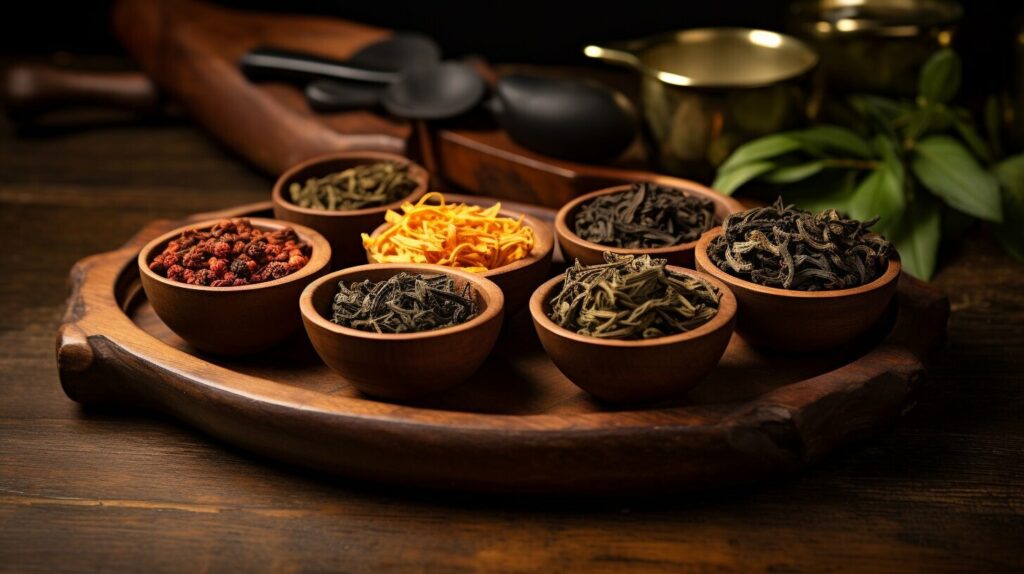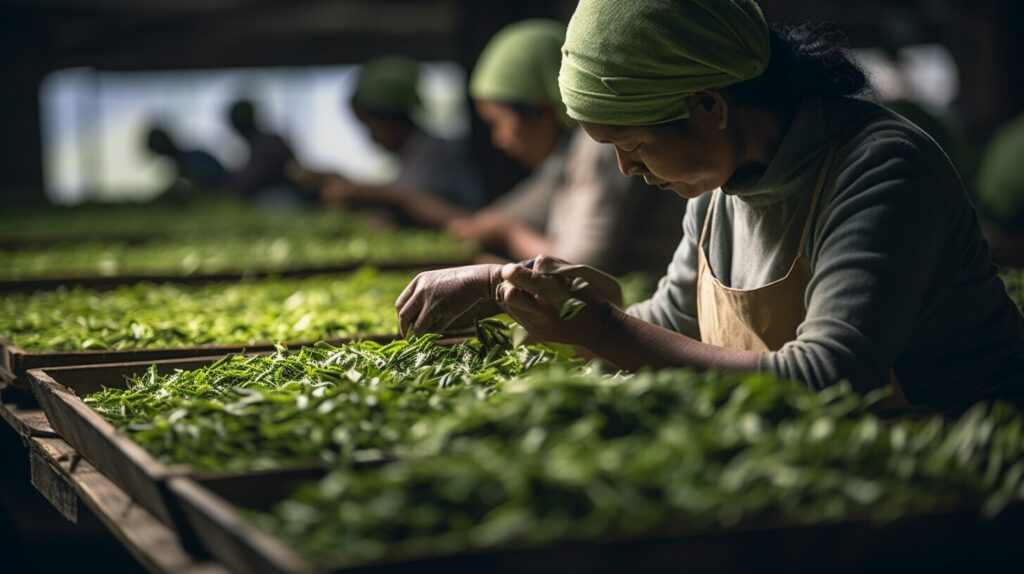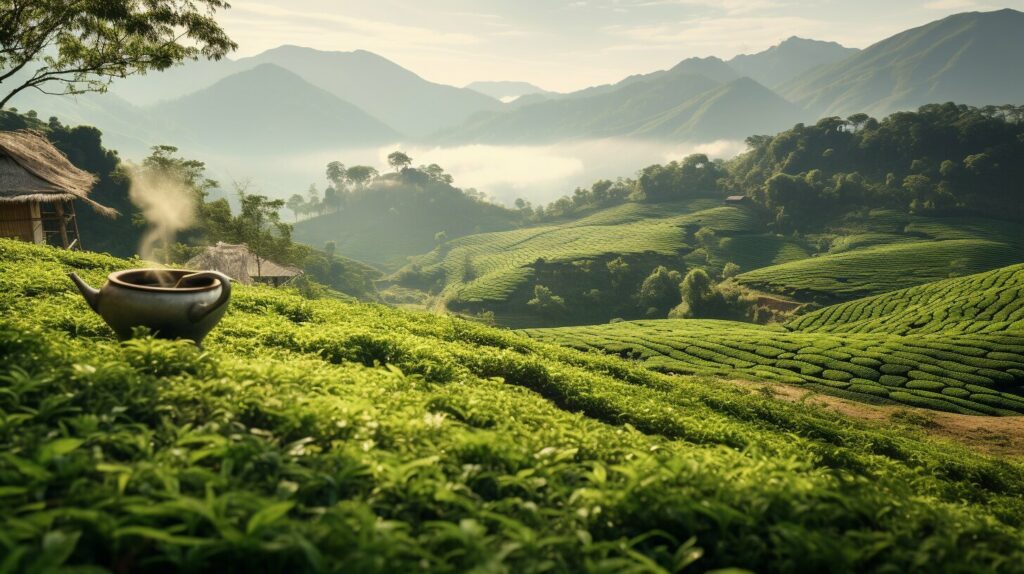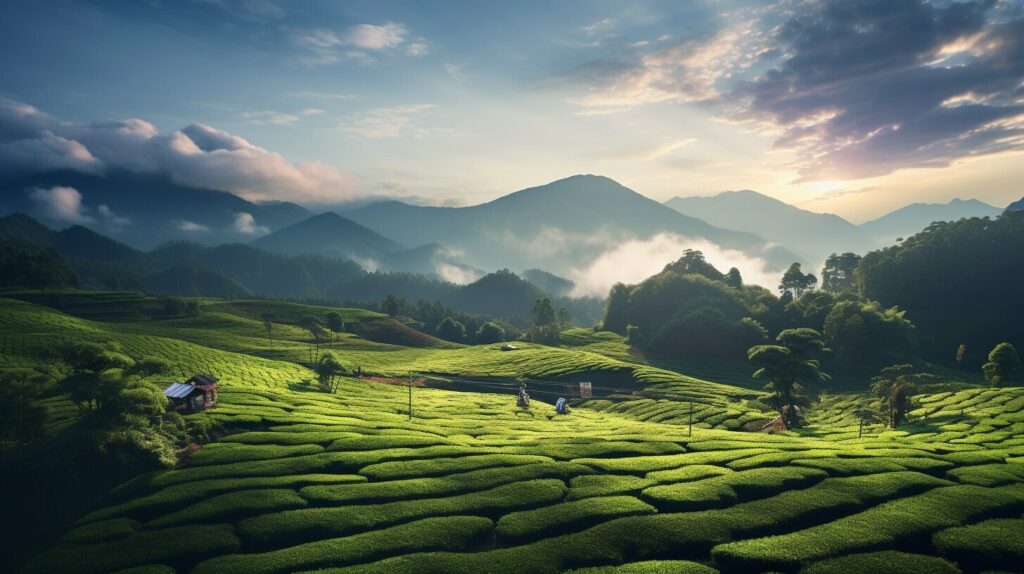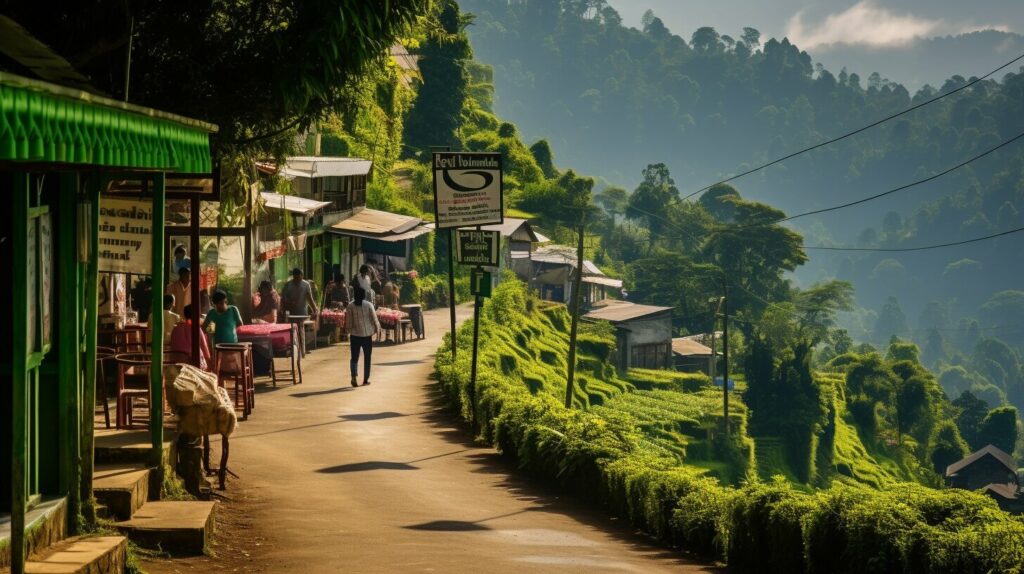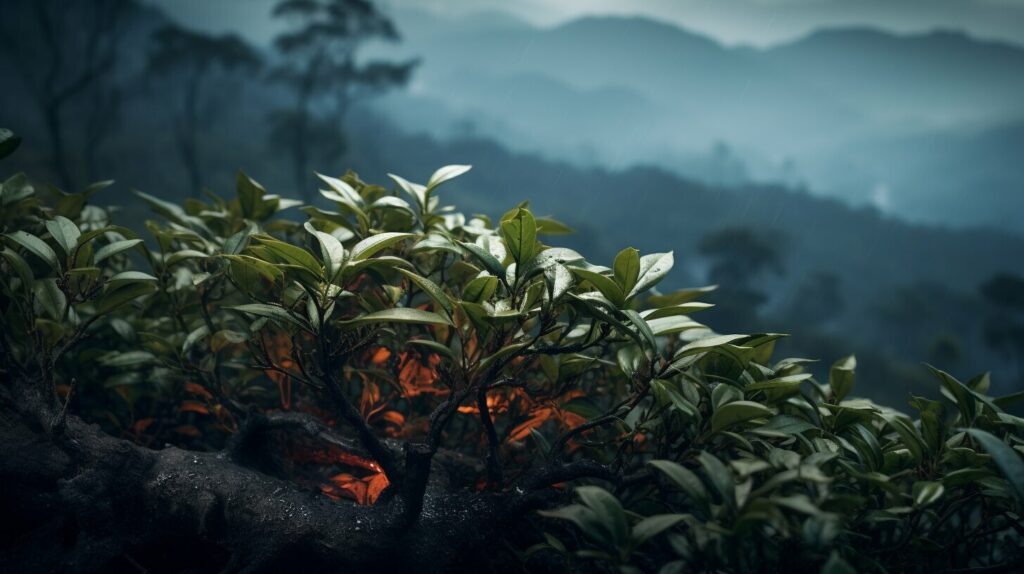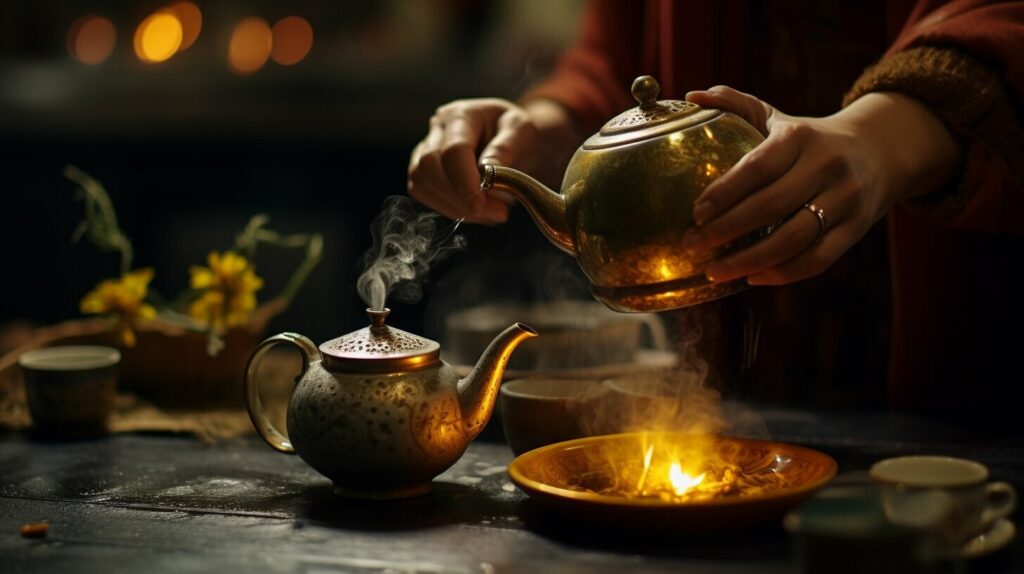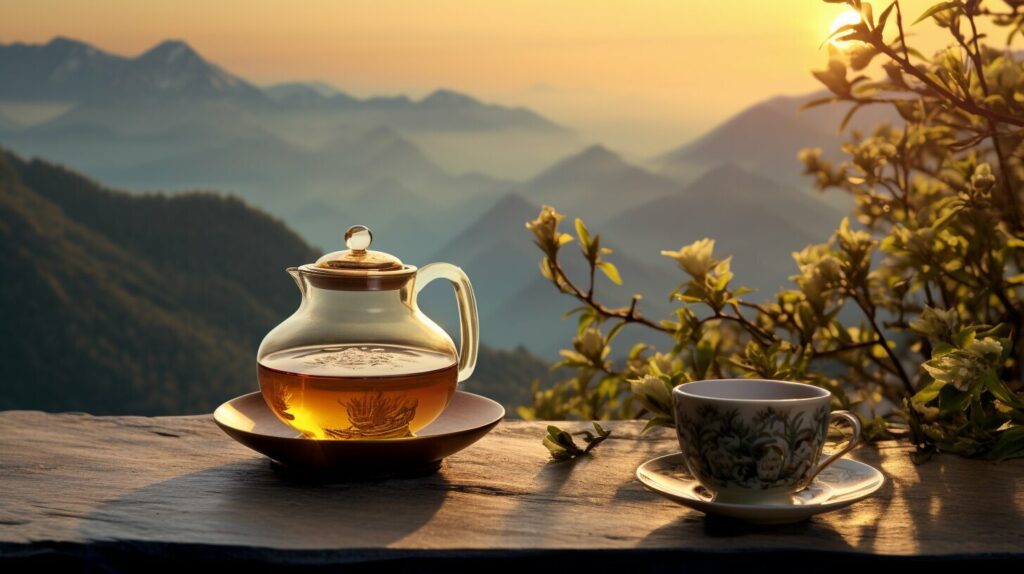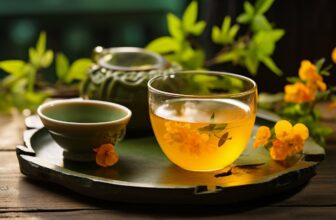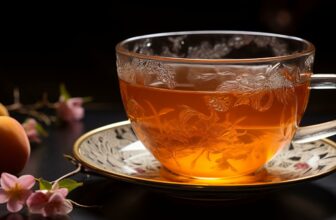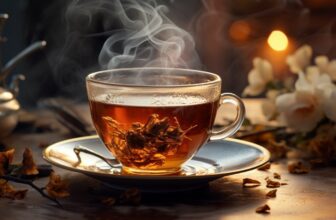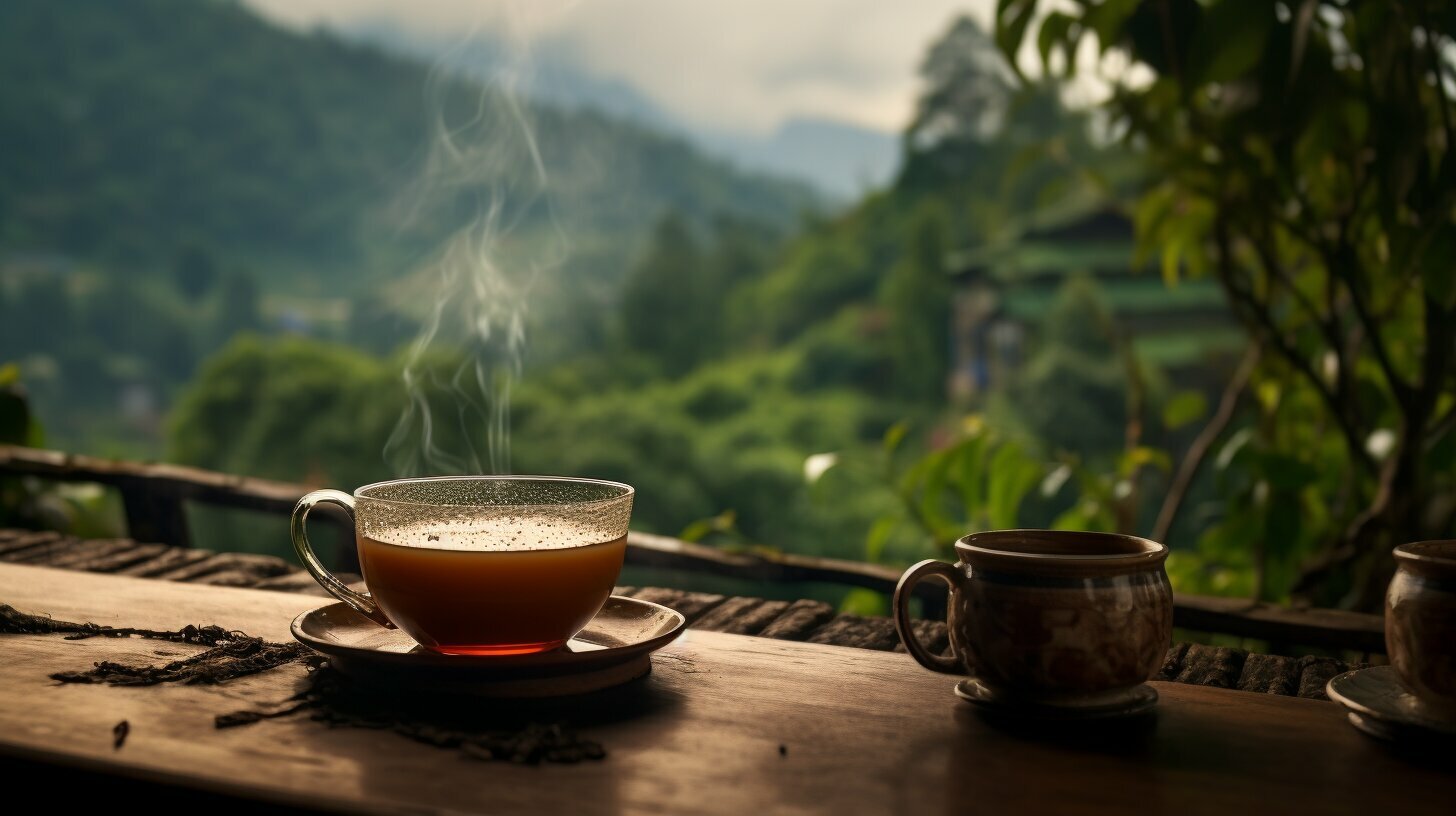
Darjeeling tea, also known as the champagne of teas, is a highly coveted beverage grown in the Darjeeling region of India. This exquisite tea is cultivated at high altitudes in the Himalayan Mountains, where the cool climate and unique terroir contribute to its distinct flavor and quality.
Key Takeaways:
- Darjeeling tea is known as the king of black teas.
- It is grown in the Darjeeling region of India, in the Himalayan Mountains.
- The tea is hand-picked and showcases exquisite craftsmanship.
- Darjeeling tea is rich in antioxidants, vitamins, and minerals.
- It has numerous health benefits, including improving cardiovascular health.
The History of Darjeeling Tea
Darjeeling tea has a rich history that dates back to the mid-19th century when it was first cultivated by the British in the misty hills of Darjeeling. The cool climate and high altitude of the region proved to be the perfect conditions for growing tea, and soon Darjeeling tea gained recognition for its unique flavor and quality.
Initially, the British established tea gardens in Darjeeling to compete with China’s monopoly on the tea trade. They experimented with different tea plants and cultivation techniques, eventually discovering that the region’s terroir, or specific environmental conditions, produced tea with exceptional characteristics.
“Darjeeling tea, with its delicate aroma and muscatel flavor, quickly became a favorite among British tea connoisseurs.”
By the late 19th century, Darjeeling tea had gained popularity worldwide and earned a reputation as the “champagne of teas.” The tea industry in Darjeeling flourished, with many tea estates being established and the region becoming synonymous with high-quality tea production.
The Cultural Significance
Darjeeling tea not only holds historical importance but also plays an integral role in the cultural identity of the region. The tea gardens of Darjeeling have become a symbol of beauty and elegance, attracting tourists from all over the world.
The tea gardens are meticulously maintained, with rows of tea bushes stretching as far as the eye can see, creating a mesmerizing sight. The tea leaves, carefully plucked by skilled tea pickers, are processed with utmost care, preserving their unique flavors and aromas.
The cultural significance of Darjeeling tea is further enhanced by the tea festivals and events held in the region. These celebrations showcase the rich tea heritage of Darjeeling, allowing visitors to experience the tea culture firsthand.
 The Journey from the Misty Hills
The Journey from the Misty Hills
Types and Flavors of Darjeeling Tea
Darjeeling tea boasts a diverse range of types and flavors, each with its own unique characteristics and tasting notes. From the traditional black tea to the delicate oolong and refreshing green tea varieties, Darjeeling tea offers a world of options for tea enthusiasts to explore.
The first and most well-known type of Darjeeling tea is the black tea, which has a rich and robust flavor. It is known for its distinct muscatel taste, often described as a combination of fruity and floral notes. The second flush black tea, harvested during the summer months, is especially prized for its exquisite aroma and complex flavor profile.
Another popular variety is Darjeeling oolong tea, which falls between black and green tea in terms of oxidation. It has a smooth and mellow flavor, with hints of fruit and a sweet, lingering aftertaste. Oolong tea from Darjeeling is highly regarded for its unique balance of flavors and its ability to be steeped multiple times.
For those seeking a lighter and more delicate option, Darjeeling green tea is an excellent choice. It has a delicate and grassy flavor, with subtle floral notes. Known for its refreshing and rejuvenating properties, green tea from Darjeeling is a popular choice for those looking to embrace a healthier lifestyle.
Whether you prefer the boldness of black tea, the complexity of oolong, or the lightness of green tea, Darjeeling offers a tea for every palate. Each cup is a journey of flavors and aromas, transporting you to the serene landscapes of the Himalayas with every sip.
| Type | Flavor | Characteristics |
|---|---|---|
| Black Tea | Rich, muscatel | Strong and robust flavor with fruity and floral notes |
| Oolong Tea | Mellow, sweet | Smooth flavor, balanced between black and green tea, with hints of fruit |
| Green Tea | Grassy, floral | Delicate flavor, refreshing and rejuvenating, with subtle floral notes |
The Production Process of Darjeeling Tea
The production of Darjeeling tea involves a meticulous and labor-intensive process, ensuring the highest quality and flavor in every cup. The journey begins with the cultivation of the renowned Camellia sinensis tea plant, which thrives in the unique microclimate of the Darjeeling region. The tea gardens, nestled among the mist-shrouded slopes of the Himalayan Mountains, provide the ideal conditions for the tea leaves to develop their distinct characteristics.
Once the tea plants have reached maturity, skilled workers hand-pluck the delicate leaves, carefully selecting only the top two leaves and a bud. This selective plucking process is crucial to maintain the tea’s unparalleled quality. The freshly picked leaves are then transported to the processing area, where they undergo a series of meticulous steps.
| Processing Steps | Description |
|---|---|
| Withering | The leaves are spread out in a cool, well-ventilated area for several hours to remove excess moisture. |
| Rolling | The withered leaves are gently rolled to release their natural oils and enzymes, which contribute to the tea’s aroma and flavor. |
| Fermentation | The rolled leaves are left to ferment in controlled temperature and humidity conditions, allowing the flavors to develop. |
| Drying | The fermented leaves are carefully dried using methods such as sun-drying or drying with hot air, preserving their unique qualities. |
| Sorting and Grading | The dried leaves are sorted according to their size, shape, and quality, ensuring consistency and uniformity in every batch of Darjeeling tea. |
Once the tea leaves have undergone these meticulous processing steps, they are carefully packaged and transported to tea connoisseurs around the world, ready to be steeped and enjoyed. The dedication and expertise of the tea farmers and workers involved in the production process contribute to the exceptional taste and aroma that Darjeeling tea is known for.
As you savor a cup of Darjeeling tea, take a moment to appreciate the craftsmanship and attention to detail that goes into each step of its production. From the careful plucking of the leaves to the intricate processing methods, every aspect contributes to the tea’s exceptional quality and the pleasure it brings to tea enthusiasts worldwide.
Health Benefits of Darjeeling Tea
In addition to its delightful taste, Darjeeling tea offers a plethora of health benefits, making it a wise choice for tea enthusiasts. This majestic tea is packed with antioxidants, such as catechins and flavonoids, which help protect the body against damage caused by free radicals. These antioxidants have been linked to reducing the risk of chronic diseases, including certain types of cancer.
Darjeeling tea also contains the amino acid L-theanine, which is known to promote relaxation and improve focus. This natural compound works in harmony with caffeine to provide a gentle and sustained energy boost, without the jitters often associated with coffee consumption.
Moreover, studies have shown that regularly consuming Darjeeling tea can have positive effects on cardiovascular health. The tea has been found to lower blood pressure and reduce cholesterol levels, thus decreasing the risk of heart disease and stroke. It also contains natural compounds that have antimicrobial properties, helping to support the immune system and fight off infections.
To fully savor the health benefits of Darjeeling tea, it is best enjoyed on its own, without the addition of milk or sugar. The brewing process is a delicate art that involves using fresh spring water and steeping the tea leaves for 3-4 minutes. This allows the flavors and nutrients to infuse into the water, creating a soothing and invigorating cup of tea.
| Health Benefits of Darjeeling Tea: |
|---|
| Rich in antioxidants |
| Promotes relaxation and focus |
| Supports cardiovascular health |
| Boosts the immune system |
Experience the goodness of Darjeeling tea and enhance your well-being with every sip. Indulge in a moment of tranquility and savor the aromatic flavors of this timeless elixir.
References:
- “Antioxidant and Antiradical Properties of Darjeeling Tea,” Journal of Food Science, Wiley Online Library, 2018.
- “The Impact of Darjeeling Tea Consumption on Blood Pressure and Lipid Profile,” BMC Complementary Medicine and Therapies, BioMed Central, 2017.
- “The Relaxation Effect of Theanine in Human,” Nippon Nogeikagaku Kaishi, 2020.
Exploring Darjeeling Tea Gardens
Darjeeling is home to breathtaking tea gardens, characterized by rolling hills, lush greenery, and a serene ambiance that adds to the allure of its tea. These picturesque gardens, nestled in the Himalayan foothills, provide the perfect environment for cultivating the world-renowned Darjeeling tea. With their unique combination of altitude, rainfall, and soil composition, these gardens produce some of the most sought-after tea leaves in the world.
Walking through the tea gardens of Darjeeling is like stepping into a tranquil haven. The air is infused with the delicate aroma of tea leaves, while the gentle rustling of the tea bushes creates a soothing symphony. It’s a captivating experience, surrounded by nature’s beauty and immersed in the art of tea cultivation.
The tea gardens of Darjeeling are meticulously maintained, with the tea bushes carefully pruned and nurtured. The plucking of the tea leaves is a labor-intensive process, with skilled workers hand-picking only the finest, tender leaves. This attention to detail ensures that every cup of Darjeeling tea is a testament to the dedication and craftsmanship of the tea garden workers.
Steeped in history and tradition, the tea gardens themselves are a sight to behold. They offer breathtaking views of the surrounding mountains, with terraced fields stretching as far as the eye can see. The serene ambiance of the gardens creates a peaceful retreat, allowing visitors to unwind and immerse themselves in the magic of Darjeeling tea.
Exploring the Darjeeling tea gardens is not just an opportunity to witness the tea-making process firsthand; it is a chance to connect with nature and experience the essence of this beloved beverage. Whether you choose to stroll through the verdant gardens or simply sit back and savor a cup of freshly brewed Darjeeling tea, the beauty and tranquility of these gardens will leave a lasting impression.
Where to Buy Darjeeling Tea
If you’re eager to savor the authentic taste of Darjeeling tea, we’ve got you covered with recommendations on where to purchase this exquisite beverage.
1. Online Specialty Tea Retailers: Explore reputable online retailers that specialize in teas from around the world. They offer a wide selection of Darjeeling tea, allowing you to choose from different grades and flavors. Look for websites that source their tea directly from Darjeeling to ensure the highest quality.
2. Local Tea Shops: Visit your nearest tea shop or specialty grocery store that stocks a variety of teas. These establishments often carry Darjeeling tea in loose leaf form, allowing you to appreciate the delicate nuances of its flavor. The knowledgeable staff can also guide you in choosing the right Darjeeling tea based on your preferences.
3. Directly from Darjeeling Tea Gardens: Some tea estates in Darjeeling offer the option to purchase their teas directly from the source. This allows you to support the local tea community and experience the true essence of Darjeeling tea. Keep in mind that shipping may take longer, but the wait is well worth it for a truly authentic experience.
Tips for Buying Darjeeling Tea:
- Look for certifications such as the Darjeeling logo or the Tea Board of India’s logo to ensure the tea’s authenticity.
- Check for the harvest date to ensure freshness.
- Consider the grade of Darjeeling tea based on your preference – first flush (light and floral), second flush (rich and muscatel), or autumn flush (robust and fruity).
- Read customer reviews and ratings to get an idea of the quality and taste.
- Experiment with different varieties and flavors to find your favorite.
Now that you know where to buy Darjeeling tea, it’s time to embark on a delightful tea-drinking journey. So make sure to get your hands on this extraordinary brew and uplift your tea-drinking experience to new heights!
| Benefits of Buying Darjeeling Tea | Where to Buy |
|---|---|
| Authenticity | Online Specialty Tea Retailers |
| Expert Guidance | Local Tea Shops |
| Experience the Source | Directly from Darjeeling Tea Gardens |
Appreciating Darjeeling Tea Leaves
The allure of Darjeeling tea lies not only in its taste but also in the exquisite tea leaves that are carefully plucked and processed. Each leaf is a work of art, reflecting the dedication and expertise of the tea growers. From the moment the first tender leaf is plucked, to the final processing that brings out its unique flavors and aromas, every step is meticulously executed to ensure the highest quality.
Darjeeling tea leaves are known for their delicate appearance and vibrant green color. They are handpicked by skilled workers, who select only the finest leaves for further processing. The leaves undergo a meticulous withering process, where they are left to dry naturally, allowing their flavors to develop. This process enhances the tea’s natural sweetness and floral notes, resulting in a truly exquisite cup of tea.
| Leaf Grade | Description |
|---|---|
| First Flush | Known as the “Champagne of Teas,” these leaves are harvested in the spring and have a light color and delicate flavor. |
| Second Flush | Harvested in the summer, these leaves have a fuller flavor and a hint of muscatel, making them highly sought after. |
| Autumn Flush | Picked later in the year, these leaves have a robust flavor and a distinct musky character. |
Whether you prefer the bright and floral notes of the first flush or the rich and fruity tones of the second flush, Darjeeling tea leaves offer a range of flavors to suit every palate. Each sip is a journey through the Himalayan mountains, where the mystical mist and cool climate impart their magic to the tea leaves. So, the next time you savor a cup of Darjeeling tea, take a moment to appreciate the beauty and craftsmanship of the leaves that make it truly exceptional.
Brewing the Perfect Cup of Darjeeling Tea
Brewing Darjeeling tea requires precision and attention to detail to fully unlock its delicate flavors and aromatic nuances. To begin, it’s essential to use high-quality spring water, as the mineral content of the water can greatly affect the taste of the tea. Fill your kettle with fresh, cold spring water and bring it to a boil.
Next, select the perfect Darjeeling tea leaves for your brew. Whether you prefer black, oolong, or green tea, make sure to choose loose tea leaves of the highest quality. Measure out one teaspoon of tea leaves per cup of water and place them in a teapot or infuser.
Pro tip: For a richer, more intense flavor, try adding an extra teaspoon of leaves.
Once your water has come to a boil, let it cool slightly for a minute or two to bring the temperature to around 195-205°F (90-96°C). Pour the hot water over the tea leaves, covering them completely. Let the tea steep for 3-4 minutes, allowing the leaves to release their flavors and aromas.
| Tea Type | Water Temperature | Steeping Time |
|---|---|---|
| Black Tea | 195-205°F (90-96°C) | 3-4 minutes |
| Oolong Tea | 195-205°F (90-96°C) | 3-4 minutes |
| Green Tea | 170-180°F (77-82°C) | 2-3 minutes |
After steeping, carefully pour the brewed tea into your favorite tea cup, taking note of its beautiful color and fragrant aroma. Darjeeling tea is best enjoyed without milk or sugar to fully appreciate its natural flavors and subtle nuances. Take a moment to savor each sip, allowing the tea to awaken your senses and transport you to the lush tea gardens of Darjeeling.
Quote: “Tea is a cup of life.” – Unknown
Whether you’re seeking a moment of tranquility or a way to unwind after a long day, brewing a perfect cup of Darjeeling tea is an art to be savored. Its exquisite flavors, delicate aroma, and numerous health benefits make it a beverage of choice for tea enthusiasts around the world. So go ahead, brew yourself a cup of Darjeeling tea and indulge in a moment of pure bliss.
Unwinding with a Cup of Darjeeling Tea
There’s something truly comforting about sipping a cup of Darjeeling tea, allowing its warmth and soothing qualities to wash away the stresses of the day. This exquisite tea, with its delicate aroma and light yet complex flavor, has long been cherished by tea enthusiasts worldwide. Whether you’re seeking a moment of tranquility or simply indulging in a well-deserved break, Darjeeling tea provides the perfect companion.
As you take your first sip, you’ll be greeted by the elegant floral notes that are characteristic of Darjeeling tea. The medley of flavors, ranging from muscatel to citrusy and nutty undertones, creates a harmonious symphony on your palate. Its smooth and gentle nature makes it enjoyable on its own or paired with a light snack, allowing you to truly appreciate its subtle nuances.
Known for its calming properties, Darjeeling tea not only relaxes the body but also soothes the mind. The ritual of brewing and preparing a cup of this exceptional tea can be a form of self-care, a moment of mindfulness that allows you to slow down and savor the present. With each sip, you can feel the worries of the day melting away, replaced by a sense of tranquility and rejuvenation.
Embracing the art of tea-drinking is a journey that transports you to the picturesque tea gardens of Darjeeling. The lush greenery and breathtaking landscapes that surround these gardens add an extra layer of beauty to the tea’s essence. From the vibrant hues of the tea leaves to the gentle aroma that fills the air, every aspect of Darjeeling tea complements the serene environment in which it is grown.
So, next time you need a moment of solace, reach for a cup of Darjeeling tea. Allow its flavors to caress your taste buds and its warmth to envelop you in a sense of calm. Unwind, relax, and indulge in the timeless elegance that only Darjeeling tea can offer.
The Timeless Elegance of Darjeeling Tea
Darjeeling tea, with its timeless elegance and unparalleled flavors, continues to captivate tea connoisseurs around the globe. Grown in the picturesque Darjeeling region of India, this exquisite tea is known as the king of black teas. Cultivated at high altitudes in the Himalayan Mountains, the tea leaves benefit from the unique climate and soil conditions, resulting in a flavor profile that is unmatched.
The process of making Darjeeling tea is a labor of love, requiring careful handpicking of the tea leaves by skilled artisans. This meticulous craftsmanship is evident in every cup, as the leaves brew to perfection, releasing a delicate yet complex blend of floral, fruity, and muscatel notes. It is this exceptional quality that has earned Darjeeling tea its reputation as one of the finest teas in the world.
Not only is Darjeeling tea a sensory delight, but it also offers numerous health benefits. Packed with antioxidants, vitamins, and minerals, this tea can help boost immunity, promote healthy digestion, and even aid in weight management. Its soothing properties make it an ideal companion for moments of relaxation and self-care, allowing you to unwind and indulge in a tranquil tea-drinking experience.
To truly appreciate the timeless elegance of Darjeeling tea, it is best enjoyed without milk or sugar. The brewing process itself is an art, involving the use of spring water and steeping the tea for 3-4 minutes. This allows the flavors to fully develop, resulting in a cup of tea that will transport you to the lush tea gardens of Darjeeling with every sip.
FAQ
Q: What is Darjeeling tea?
A: Darjeeling tea is a type of black tea grown in the Darjeeling region of India. It is known for its distinct flavor and high quality, thanks to its cultivation at high altitudes in the Himalayan Mountains.
Q: Where is Darjeeling tea grown?
A: Darjeeling tea is grown in the Darjeeling region, located in the northeast of India. The region’s unique climate and altitude contribute to the tea’s exceptional taste and character.
Q: How is Darjeeling tea made?
A: The process of making Darjeeling tea is labor-intensive. The tea leaves are carefully handpicked, showcasing the craftsmanship involved. The tea undergoes a meticulous process of cultivation, harvesting, and processing to ensure its distinct flavor and quality.
Q: What are the health benefits of Darjeeling tea?
A: Darjeeling tea is rich in antioxidants, vitamins, and minerals, making it beneficial for overall health. It can help reduce the risk of chronic diseases and improve cardiovascular health. Drinking Darjeeling tea without milk or sugar allows you to fully enjoy its natural health benefits.
Q: How should I brew Darjeeling tea?
A: To brew the perfect cup of Darjeeling tea, use spring water and steep the tea leaves for 3-4 minutes. It is best enjoyed without milk or sugar to fully appreciate its flavors and aromas.
Q: Where can I buy Darjeeling tea?
A: Authentic Darjeeling tea can be purchased both online and in physical stores. Look for reputable sellers who specialize in tea to ensure you are getting genuine Darjeeling tea.
Q: What types of Darjeeling tea are available?
A: Darjeeling tea comes in various types, including black tea, oolong tea, and green tea. Each type offers a unique flavor profile, allowing tea enthusiasts to explore their preferences.
Q: Are there any special techniques to appreciate Darjeeling tea leaves?
A: Darjeeling tea leaves are known for their exquisite appearance and aroma. Take the time to observe the leaves, inhaling their fragrance before brewing. Appreciating the tea leaves adds to the overall experience of enjoying a cup of Darjeeling tea.
Q: Does Darjeeling tea help with relaxation?
A: Many people find that the soothing qualities of Darjeeling tea help promote relaxation and a sense of calm. Taking a moment to savor a cup of Darjeeling tea can be a wonderful way to unwind and enjoy a moment of tranquility.
Q: What is the cultural significance of Darjeeling tea?
A: Darjeeling tea holds a special place in the hearts of tea enthusiasts. Its rich history, cultural impact, and timeless elegance have made it a beloved beverage around the world. Indulging in Darjeeling tea is a way to connect with tradition and experience the joy of tea-drinking.
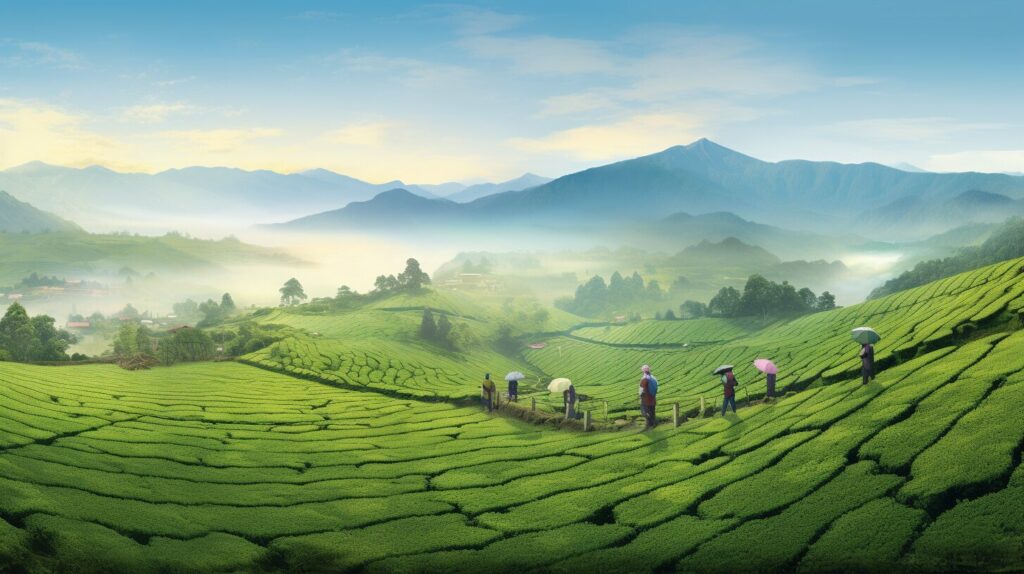 The Journey from the Misty Hills
The Journey from the Misty Hills